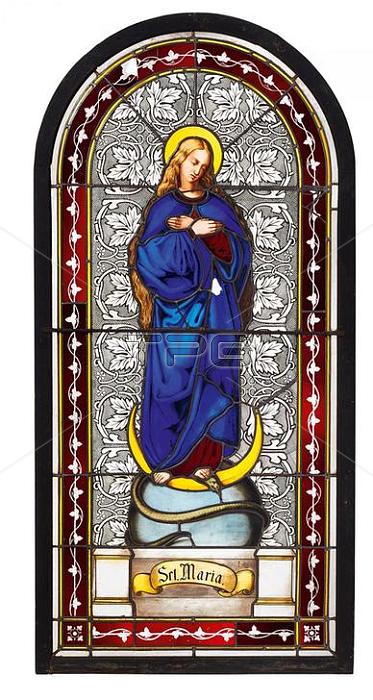
LARGE HISTORICISM WINDOW WITH DEPICTION OF MARY IMMACULATA.
South Germany. 2nd half of the 19th c. Presumably from the Royal Bavarian court stained-glass painter Matthias Schneider in Regensburg.
Stained glass; partly painted and grisaille painting. Red overlay glass. Lead came. Stone base with the scroll Sct. Maria. Above that Mary in a wide blue robe and red undergarment standing on a crescent; stepping on the head of the snake. A pattern made of vines in the background as a frame. Incl. frame 219X104cm. Condition C. Subsequent wooden frame.
Provenance:
Private collection South Germany.
The depcition is of Mary as the so-called Mary Immaculata; the Mary of immaculate conception. This means that Mary was conceived and born without the original sin. This is not to be confused with the virgin birth; but refers to Mary's birth by her mother Anna. Since the Middle Ages; this teaching about the immaculate conception had been discussed controversially between theologists; and especially between Franciscans and Dominicans; and lead to various opinions about the time when this removal of the original sin by God took place. It was not until 1854 that a coherent teaching was established by Pius IX; who proclaimed the immaculate conception as a dogma in his bull Ineffabilis Deus. Since then; the Roman-Catholic church celebrate the 8th of December; nine months after the Mary's birth; as the solemnity of the Feast of the Immaculate Conception. The pope's dogma made the depiction of the Immaculata very popular in the following decades.
In the 19th century; South Germany and especially Munich were the most imporant centres of glass painting in Germany. As the demand of leadlighting increased during this period of the Gothic Revival; with a heightened clerical building activity; outstanding glass manufacturers developed in other places as well; for example in Regensburg; where Matthias Schneider opened a workshop for glass painting in 1865. This founding was promoted and supported by the Regensburg cathedral vicar Georg Dengel; who was appreciative of art. In the former Benedictine abbey is a window with a very similar depiction of Mary; as Biburg belonged to the draw area of the Schneider company; and it can be speculated that the window was made there. A graphic template from the elaborate collection of the D黶seldorf Verein zur Verarbeitung religi鰏er Werke was presumably used as a model.Art trade; Van Ham.
| px | px | dpi | = | cm | x | cm | = | MB |
Details
Creative#:
TOP28415320
Source:
達志影像
Authorization Type:
RM
Release Information:
須由TPG 完整授權
Model Release:
No
Property Release:
No
Right to Privacy:
No
Same folder images:

 Loading
Loading